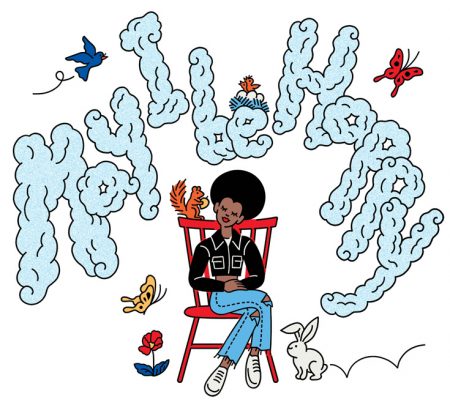
Metta Meditation: A Complete Guide to Loving-Kindness
Increased compassion for ourselves and others, better relationships, and decreased stress and anxiety are just some of the benefits of metta meditation, or loving-kindness practice. In this step-by-step guide, we lead you through the how and why of compassion practice with written, audio, and video instruction.
Illustrations by Tomi Um.
What is Metta?
Metta meditation, or loving-kindness meditation, is a Buddhist practice for cultivating compassion for ourselves and others through directing loving, friendly phrases and goodwill. The word “metta” is a Pali word, most often translated as loving-kindness, but has also been translated as universal goodwill or loving-friendliness. The practice originates from the historical Buddha’s early discourse on immeasurable friendliness, the Metta Sutta.
Metta is a concentration and mindfulness practice that invites the practitioner into a more loving, connected state of mind. This loving-kindness practice can be practiced anywhere, anytime, be it on a meditation cushion, driving in traffic, or walking down a busy street.
“In metta, we work to develop feelings of ease and love as boundless as the oceans that nourish and sustain our world,” writes Buddhist teacher Josh Korda. It’s a big challenge with a bigger reward. The results of metta can change how we see ourselves, in turn changing how we see the world.
Why Practice Loving-Kindness?
Through metta, we become more honest and loving toward ourselves and the world around us. In metta meditation, we wish happiness, safety, and ease toward ourselves and others. In the most common version of metta practice, we offer these feelings of goodwill through the use of simple phrases first to ourselves, and in succession to someone we love, someone we’re indifferent towards, someone we consider a “difficult person,” and finally to all beings, everywhere. This allows us to begin our loving-kindness practice with feelings most accessible to us, and work up to more difficult feelings, such as sending love to someone you have a negative relationship with.
Some examples of the phrases you might use in metta practice are:
- “May I be safe, healthy, and happy.”
- “May you be filled with loving-kindness.”
- “May all beings be peaceful and filled with joy.”
At first, some people might find the practice of metta too mushy or sentimental, or struggle to feel the connection metta promises. Others might struggle to direct loving feelings toward someone they consider a difficult person. As Buddhist teacher Melvin Escobar writes in his teaching on metta meditation, the practice of metta can be compared to lifting weights: If we begin with a weight that’s too heavy for us, we might end up hurt, or give up. “Likewise,” writes Escobar, “we can harm ourselves by trying to practice metta with a very difficult person [in mind], if we haven’t developed the capacity to work with the aversion and despair that may arise.”
Therefore, we begin the practice of metta incrementally, starting with ourselves, a being we consider beloved — such as a mentor, child, or pet — and when we’re ready, we work up to a more difficult person. With practice, the benefits of metta can be transformative.
Benefits of Compassion Practice
- Improved social and familial relationships
- Increased self-love, self-compassion, and self-worth
- Transformation of emotional pain
- Enhanced sense of connection and belonging to the world
- Better mental and emotional health
- Decreased stress and anxiety

How to Do Metta
Step-by-Step Loving-Kindness Meditation
Here’s how to practice metta meditation. To begin, find a quiet, uplifting place where you can do your loving-kindness practice, setting aside 15-20 minutes to complete the meditation. You can do this practice with your eyes open or closed.
1) Sit comfortably, in a chair or on a meditation cushion. Allow your body to feel at ease and supported by the surface beneath you. Begin to connect to your breath, focusing on the inhale and exhale until your breath finds a natural flow.
2) Bring your attention to your heart area. You may wish to bring a hand to your heart, or leave them comfortably rested on your knees. Begin to offer loving-kindness to yourself by repeating these phrases, allowing ample space between each one:
May I be safe
May I be healthy
May I be happy
May I be at ease
May I be filled with loving-kindness
May I be peaceful
3) Next, think of someone you love and care about. This can be a family member, friend, a pet, or someone helpful in your life. Picture them in your mind, and offer them the same phrases of loving-kindness:
May I be safe
May you be healthy
May you be happy
May you be at ease
May you be filled with loving-kindness
May you be peaceful
4) If you find your mind wandering, return to the rhythm of your breath. Next, call to mind a person you consider difficult. This could be someone you’ve had a disagreement with, or any sort of difficulty with. If this feels too painful at first, send yourself the loving-kindness you need. Imagine this person in your mind, and allow your heart to soften toward them by repeating the phrases again:
May all beings be safe
May they be healthy
May they be happy
May they be at ease
May they be filled with loving-kindness
May all beings be peaceful
Guided Metta Practice
Guided Audio Practice
A guided loving-kindness, or metta, meditation from Sharon Salzberg, author of Loving-Kindness.
Guided Video Practice
In this video from the Lion’s Roar online learning course “How to Cultivate a Loving Heart: The Buddhist Practice of Metta,” Joanna Hardy shares a metta practice directed at yourself. You can use this video on its own, or as a starting point to start working with metta meditation.
Teachings and Articles on Metta and Loving-Kindness
There’s a true wealth of loving-kindness teachings on lionsroar.com. Below are are some particularly great resources for those new to the practice.
Metta teachings
How to Be a Light in the Dark
Dharma practitioner Mark Van Buren shares a story to help you open your heart, slow down, and pay attention with extra warmth and care this season.
How to Step Out of Your Stories and Into the Present
Leslie Gossett shares the power of creating and changing your own story.
Who Is Invisible to You?
Lisa Ernst asks us to notice who we don’t notice.
A Loving-Kindness Meditation to Heal Your Inner Child
Peggy Rowe Ward and Larry Ward on how to give the wounded child inside you the love and compassion they deserve.
The Daily Practice of Self-Kindness
You have enlightened nature, says Pema Khandro Rinpoche. If you truly know that, you’ll always be kind to yourself.
The Four Highest Emotions
Ayya Khema on cultivating loving-kindness, compassion, sympathetic joy, and equanimity.
How to Love Yourself
If you want to love all beings, start with self-love, says Lisa Ernst.
Metta is Not for Wimps
Chenxing Han reflects on the courage and vulnerability required to practice loving-kindness amid political division, offering us a glimpse into how compassion can transform fear into connection in uncertain times.
Toward a Worldwide Culture of Love
The practice of love, says bell hooks, is the most powerful antidote to the politics of domination.
A Practice for Developing Kindness Toward Yourself
Valerie Mason-John shares a meditation for cultivating a positive relationship with yourself, and, by extension, the world.









